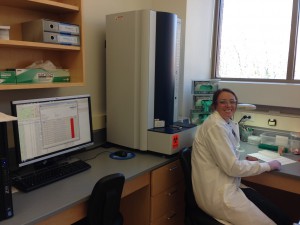State-of-the-art MALDI-TOF Technology at WVDL Identifies Emerging Bacterial Pathogens

The Microbiology Section at WVDL has been using a MALDI-TOF machine to rapidly and accurately identify bacterial pathogens for several months now, starting in the spring of 2014. MALDI-TOF is a matrix-assisted laser desorption ionization/mass spectrometry machine that identifies bacteria based on their unique signature. Along with the usual pathogens the MALDI-TOF unit has been identifying several emerging bacterial mastitis pathogens, such as Lactococcus garvieae, which is aiding bovine veterinarians to improve milk quality and profitability on Wisconsin Dairies.
Contact the WVDL if you receive a culture result with a microbial species that is new to your practice for more information.
The following is a recent article from Veterinary Microbiology highlighting the MALDI-TOF’s ability to speciate hard to identify Corynebacterium spp.
Vet Microbiol. 2014 Sep 17;173(1-2):147-51. doi: 10.1016/j.vetmic.2014.06.028. Epub 2014 Jul 7.
Identification of Corynebacterium spp. isolated from bovine intramammary infections by matrix-assisted laser desorption ionization-time of flight mass spectrometry.
Author information: Gonçalves JL1, Tomazi T1, Barreiro JR1, Braga PA2, Ferreira CR2, Araújo Junior JP3, Eberlin MN2, Santos MV4.
Abstract
Corynebacterium species (spp.) are among the most frequently isolated pathogens associated with subclinical mastitis in dairy cows. However, simple, fast, and reliable methods for the identification of species of the genus Corynebacterium are not currently available. This study aimed to evaluate the usefulness of matrix-assisted laser desorption ionization/mass spectrometry (MALDI-TOF MS) for identifying Corynebacterium spp. isolated from the mammary glands of dairy cows. Corynebacterium spp. were isolated from milk samples via microbiological culture (n=180) and were analyzed by MALDI-TOF MS and 16S rRNA gene sequencing. Using MALDI-TOF MS methodology, 161 Corynebacterium spp. isolates (89.4%) were correctly identified at the species level, whereas 12 isolates (6.7%) were identified at the genus level. Most isolates that were identified at the species level with 16 S rRNA gene sequencing were identified as Corynebacterium bovis (n=156; 86.7%) were also identified as C. bovis with MALDI-TOF MS. Five Corynebacterium spp. isolates (2.8%) were not correctly identified at the species level with MALDI-TOF MS and 2 isolates (1.1%) were considered unidentified because despite having MALDI-TOF MS scores >2, only the genus level was correctly identified. Therefore, MALDI-TOF MS could serve as an alternative method for species-level diagnoses of bovine intramammary infections caused by Corynebacterium spp.
Copyright © 2014 Elsevier B.V. All rights reserved.